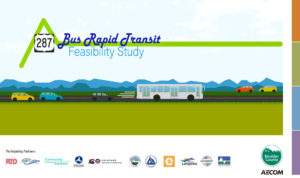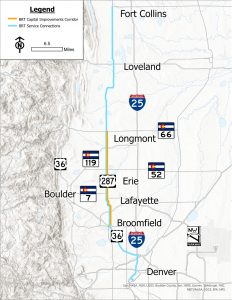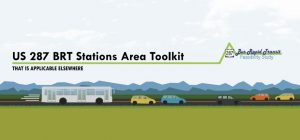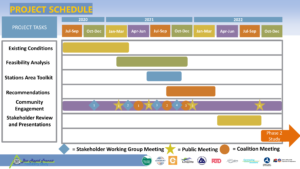Phase I: US 287 Bus Rapid Transit Feasibility Study available for public review
In collaboration with our many agency partners and local communities, in April 2022 Boulder County completed the US 287 Bus Rapid Transit Feasibility Study (full study)(executive summary).
Recommendations include three bus service patterns with modifications to operations, stations, and intersections such as queue jumps that permit buses to utilize sections of right turn lanes to avoid congestion. The Phase I full study and executive summary detail these recommendations.

Project Overview
Over 18 months, the project team worked with technical staff, elected officials, and members of the public to create a vision for US 287 with Bus Rapid Transit (BRT) as a central component.
This corridor is important to serve people living, working, and traveling to/from the growing communities and key destinations along the corridor and beyond, offering connections with other local and regional transit routes. The US 287 corridor serves as the north/south spine of the Northwest Area Mobility Study’s (NAMS) network of regional BRT routes. Enhancing transit service along the corridor connects routes countywide and creates the opportunity to increase transit ridership throughout the region.
Community engagement played an important role in shaping this study, including the proposed recommendations and next steps to phase in regional and inter-regional transit improvements along the US 287 corridor. Through this planning process, we heard from the public that in addition to improved transit services, safety is important for all users alongside and crossing US 287.
The study recommends the type and location of capital investments that will enhance transit travel times on US 287. The study assesses and analyses traffic patterns, current transit operations and facilities, vehicle queue lengths, intersections treatments, and created a Station Areas Toolkit. The study identifies potential funding sources and provides the framework for the next steps for the implementation of BRT along US 287.

Project Background
In 2014, the Northwest Area Mobility Study (NAMS) identified US 287 as a strong candidate for implementing BRT and found that US 287 had the highest projected ridership among the other corridors the study analyzed. As a result, the NAMS recommended that US 287 should be prioritized for implementation. Since the NAMS, the area around US 287 has experienced continued population and employment growth, further increasing travel demand. This BRT feasibility study will build off of the NAMS study and develop a multi-modal vision for the BRT implementation on US 287.
Project Partners
Boulder County convened a Stakeholder Working Group to closely collaborate with the planning team throughout the feasibility study process. The Stakeholder Working Group consists of agency representatives from the City and County of Broomfield, the City of Longmont, the Town of Erie, Commuting Solutions, Transfort, the City of Lafayette, the Regional Transportation District, the Colorado Department of Transportation, the Federal Highway Administration, the Federal Transit Administration, Commuting Solutions, and economic development entities. The Stakeholder Working Group met regularly throughout the planning process.





